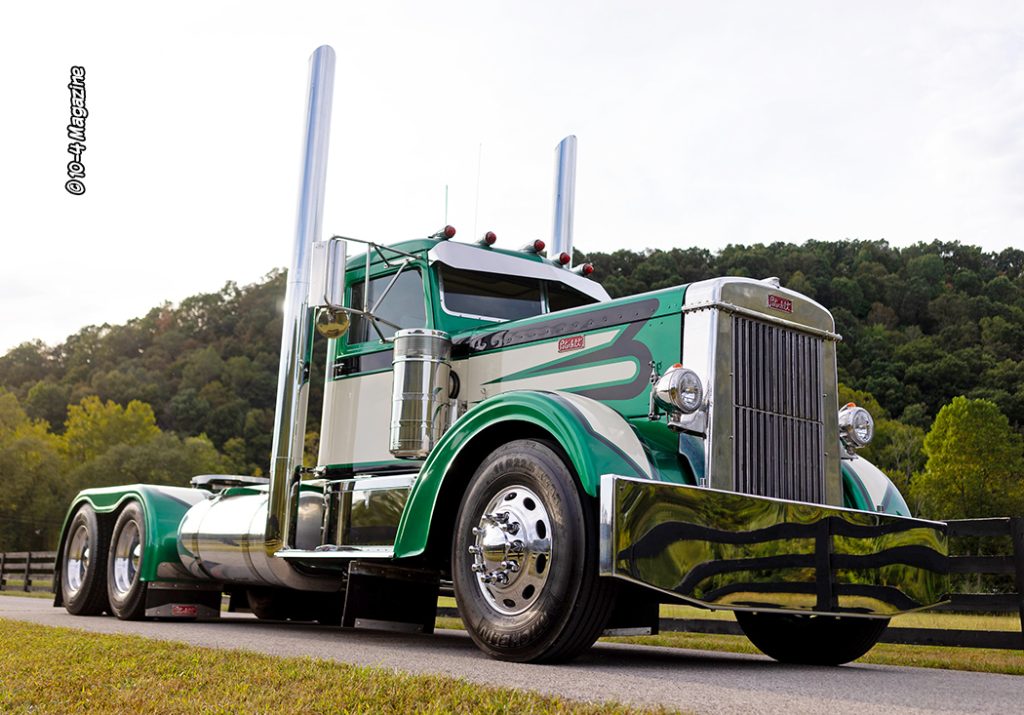
When T.A. Peterman founded the Peterbilt Motors Company in 1939 from the remnants of the Fageol Truck Company, which had fallen on hard times due to the Great Depression, little did he know how popular the trucks that carried his name would become in the decades to follow. While many different Peterbilt models have been built over the years, many of these trucks are sought after, such as the “needle nose” model 351, the model 359, and 379 extended hoods. These rigs have virtually defined the image of the true American owner operator and are as iconic as a cowboy and his horse from the old west.
To many, a Peterbilt is considered to be a status symbol. With their big hoods, classic styling, and loads of options, along with aftermarket support, there’s no shortage of chrome, stainless steel, and lighting accessories for many Peterbilt models. In a sense, these trucks are “catalog” trucks, meaning you can get the same parts and accessories as every other Peterbilt rollin’ down the highway. But for some Peterbilt trucks, you just can’t get parts anymore, and you can’t go to the dealership or order the parts out of a catalog, either. Needless to say, it can be a challenge to restore and/or rebuild some of the early Peterbilt models – just ask David Price.
As the owner of Price Solutions, based in Olive Hill, Kentucky, David Price loves a challenge. His company provides crane services, moving extra-large and heavy objects for the mining industry, so challenges are just part of his everyday life. So, when the opportunity to purchase a rare 1949 Peterbilt model 350 presented itself, David bought the truck, knowing it would be a challenge to restore, and then went all in.
Produced from 1949 through 1957, the model 350 came to be known as the “Iron Nose” by Peterbilt fans due to its large grill and vertical radiator shutters. The most famous example of the 350 in trucking lore is the “El Turbo” Peterbilt, also a 1949, which was owned and operated by Gene and Hilda Smith for many years. This iconic rig was a common sight, working out west, for decades. The truck was later purchased by collector Jerry Howard of Fairborn, Ohio, and after Jerry’s death in 2021, “El Turbo” now resides in the Keystone Antique Truck and Tractor Museum in Colonial Heights, Virginia.
Not only did David’s 350 not have the historical prominence of the “El Turbo” truck, but it was also far from a beauty queen at all when he acquired it. The truck was essentially a roller, with no engine and no transmission. An attempt at restoration had been made once before on the truck, but needless to say, it was less than satisfactory. David told us that he unfortunately doesn’t know the history of his truck, like who it was first built for, who has owned it throughout its life, its actual mileage, and what its original powertrain was – all of this is still a mystery.
However, with a vision in mind, David set out to build one of the most impressive and cool 1949 Peterbilts in existence. With a worn-out cab and butterfly hood, riding on a worn-out aluminum frame, David quickly found he couldn’t get readily available parts for this truck. While he was able to source certain parts from Courtland Truck Works in California, who specialize in vintage Peterbilt restorations and parts, David went to work rebuilding the cab and other structural components of the Peterbilt, along with re-skinning parts of the cab and hood.
Wanting the truck to retain its old and traditional look but be comfortable to drive, David decided to equip the rig with a modern powertrain from a current Class 8 truck, which would make it “a fun, unique, driver friendly truck,” as he explained. So, with no expense being spared, new aluminum frame rails and cross members began as the base for the Peterbilt, with its wheelbase being stretched to an impressive 240-inches. To keep the cool factor going, David installed a car hauler Pete low air-leaf suspension on the truck, along with a full set of 24.5 Alcoa aluminum rims, wrapped in low-pro Michelin rubber.
As the truck was slowly coming together, David still needed an engine and transmission. Since he was going modern with his “Old School” Peterbilt, he had a wrecked 2007 Peterbilt 379 sitting at his shop that had been getting cannibalized for parts. Looking at the ‘07 Pete and then at the ‘49, David got the idea to use the big 550-hp Caterpillar 3406E 2WS, which was upgradeable to 625 hp, in the Iron Nose. After taking some measurements, both the trucks had a 127” BBC, but he wondered if the big Caterpillar would even fit. Sure enough, after pulling the CAT, David’s shop placed the big 2WS in the 1949 model 350. While a tight fit, the big CAT sat snugly under the butterfly hood, with a minimum amount of room to spare.
With the “King of the Hill” CAT in place, David mated the engine to an Eaton-Fuller 18-speed transmission, with power being pushed out to 3.55 rear-ends. While the vintage Pete looks old, it’s about as modern as it gets inside. With the modern electronics installed in order to run the engine, the cab was completely rewired. New gauges from Rockwood were mounted in the dash panels, with a custom interior being manufactured by Steve Holcomb for the truck, as well. Painted in a beautiful ivory, green, and black paint scheme, the truck is highlighted by a big Texas bumper, a stainless visor, 8-inch dual exhaust pipes, polished aluminum fuel tanks, and a full set of stainless steel fenders, placed over the drive axles, along with plenty more goodies adorning David’s classic Peterbilt.
After a year of non-stop work, the Pete rolled out of David’s shop for the first time under its own power in May 2019. Wanting to show it off, David took it to a local car show at a truck stop in the area. Being the only truck in the car show, and not to mention an extremely rare and unique Peterbilt, the truck received a lot of attention and the show organizers had David park his impressive rig at the front of the show for everyone to see. While David was proud to simply show off his vintage 1949 Iron Nose Peterbilt, he did tell us the truck won a couple of trophies that day, too. When building or customizing an older truck like this, the “price” of cool isn’t cheap – just ask David Price!
EDITOR’S NOTE: Big thanks go out to Dylan Lambert for providing all the photos for this feature.

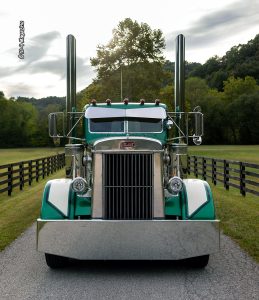
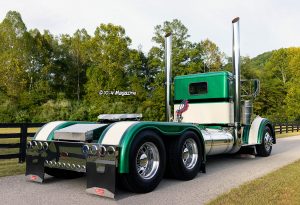
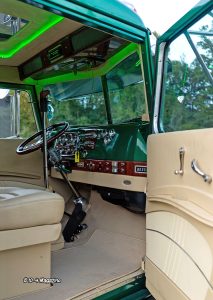
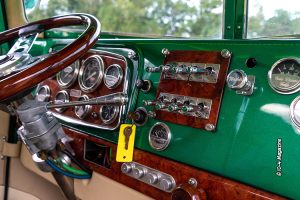
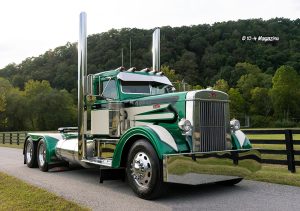
4 Comments
Now, that’s COOL! How did a radiator large enough to cool the big Cat get installed? Great rig.
I restored a 1957 KW originally owned by Nalley’s Food’s from Tacoma WA. I was able to get the build sheet on it.I went with steel rails instead of aluminum. Put a N 14 mechanical in it with a 6X4 TRANSMISSION set up. It’s a lot of fun.
I AM SOMEONE WHO LOVES THE PETERBUILT TRUCKS!
FOR MY GRANDPA DROVE ONE, IT WAS 18 SPEED BACK IN THE 70s.
His CB Handel was Cherokee Cheif out of SC & THATS MY HANDEL TODAY.
I am Lloyd .
Ktt8273@gmail.com
Beautiful colors and scheme..